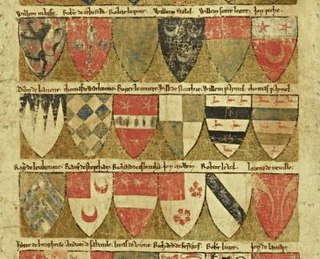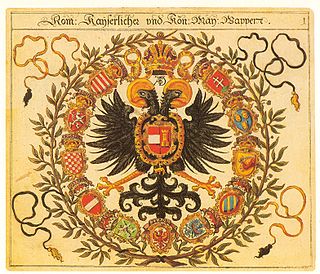 W
WAn ordinary of arms is a roll or register of coats of arms arranged systematically by design, with coats featuring the same principal elements grouped together. The purpose of an ordinary is to facilitate the identification of the bearer of a coat of arms from visual evidence alone.
 W
WArmorial of Little Russia is an armorial of noble Ukrainian families from the Russian Empire. It was published in 1914, in Saint Petersburg, by the nobility of Chernigov Governorate. The Armorial was edited by Russian historian Vladislav Lukomski and Ukrainian historian Vadym Modzalevski, and illustrated by Ukrainian artist Heorhiy Narbut. It contains images and description of 700 coats of arms of Ukrainian, predominantly Cossack, families.
 W
WThe Armorial Wijnbergen, also known as the Wijnbergen Roll, is a medieval French roll of arms. It is divided into two parts; the first, dated c. 1265–1270 has 256 coats of arms of the vassals of Louis IX of France in the Île-de-France; the second part, dated c. 1280, has 1,056 coats of arms of the vassals of Philip III of France in his fiefs in the North of France, the Netherlands and the Rhineland.
 W
WThe Belgrade Armorial II is the name given to an armorial compiled between 1600 and 1620, as a copy of Petar Ohmućević's armorial which is dated to c. 1590. It was bought by Russian historian Alexander Soloviev in 1936, and is today held at the Museum of Applied Art in Belgrade. It is among the oldest, and finest of the Illyrian Armorials. Its origin remain unknown.
 W
WThe Libro del Conosçimiento de todos los rregnos or Book of Knowledge of All Kingdoms, also known as the Book of All Kingdoms, is an anonymous 14th-century Castilian geographical and armorial manual. It is written in the form of imaginary autobiographical travelogue of a Castilian mendicant friar, as he travels through the entire world, known and fanciful, from the westernmost Atlantic islands, through Europe, Asia, Africa and the Arctic, identifying all the lands, kings, lords and their armorial devices as he passes them. The only explicit information is that the anonymous author claims to have been born in Castile in 1305.
 W
WCodex iconographicus monacensis 236 is an armorial of the coats of arms of the attendants of the imperial diet of 1594 at Regensburg Rudolf II in 1594 declared Regensburg would be the sole location where imperial diets were to be held in the future.
 W
WThe Dering Roll is the oldest English roll of arms surviving in its original form. It was made between 1270 and 1280 and contains the coat of arms of 324 knights, starting with two illegitimate children of King John. Sir Edward Dering acquired the roll during the 17th century and modified it to include a fictitious ancestor of his own. It was eventually purchased by the British Library following fund raising involving a number of other charities and individuals.
 W
WFojnica Armorial is a prominent Illyrian armorial which contains South Slavic heraldic symbols, and expresses romantic nationalism and illyrism rather than historical accuracy. The manuscript is named after the Franciscan monastery in Fojnica where it was kept.
 W
WThe Gelre Armorial is a medieval armorial.
 W
WThe General Armorial of the Noble Families of the Russian Empire is the register of arms of the Russian noble families, established by decree of Emperor Paul I of January 31, 1797.
 W
WThe Hyghalmen Roll is a roll of arms kept at the English College of Arms in London. It was made c. 1447–1455 in Cologne, Germany. Some images show characteristics of German heraldry, such as repeating themes in the coat of arms and crest, and the long schwenkel on banners. The latter was omitted from the attributed arms of Jesus when the images were copied into Randle Holme's Book.
 W
WThe Ingeram Codex is an armorial of the Holy Roman Empire made by Hans Ingeram for Albert VI, Archduke of Austria in 1459. It is largely concerned with the coats of arms of the Adelsgesellschaften fashionable at the time, a type of society or order formed by members of the lower nobility with the purpose of holding tournaments.
 W
WThe Korjenić-Neorić Armorial is a 1595 copy of the lost original of the Ohmućević Armorial commissioned by Petar Ohmućević, a Spanish admiral of Ragusan origin, at some point between 1584 and 1594. It is an example of the earliest ("Interconfessional") form of Illyrism, which formed the ideological basis for the later rise of South Slavic nationalism in the Balkans.
 W
WThe so-called Scheibler Armorial is an armorial manuscript compiled, in two separate portions, over the course of the 15th to 17th centuries. It is named for its first known private owners, the baronial Scheibler family of Hülhoven in the Rhineland.
 W
WSiebmachers Wappenbuch is a roll of arms first published in 1605 as two heraldic multivolume book series of armorial bearings or coats of arms of the nobility of the Holy Roman Empire, as well as coats of arms of city-states and some burgher families. Founded and compiled by Johann Ambrosius Siebmacher, a German heraldic artist, copperplate engraver, etcher and publisher from Nuremberg, these works became an important source of heraldry of the German-speaking regions.
 W
WThe Wernigerode Armorial is an armorial compiled in southern Germany in the late 15th century.
 W
WThe Zurich armorial is a roll of arms made in c. 1340 presumably in what is now eastern Switzerland ; it is now kept in the Swiss National Museum in Zurich.